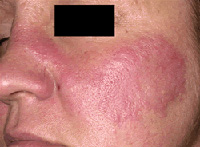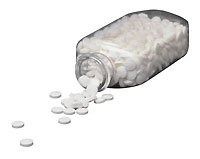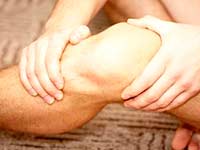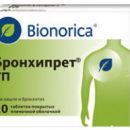How sclerodermia is manifested? What are the symptoms of the disease? How to diagnose and treat sclerodermia? Answers to the questions you will find in the article.
Content
What is sclerodermia
Sclerodermia - chronic inflammatory disease of the connective tissue, which in classical cases amazes the skin, but may also capture the gastrointestinal tract, heart, lungs, kidneys and synovial fabrics. Skin lesions, which are a cardinal sign of the disease, can be focal, linear or generalized, with a symmetric distribution of skin elements. The latter form is usually accompanied by systemic lesions (progressive systemic sclerosis) and typical for adult patients. In children, sclerodermia usually has a focal form; Systemic lesions are rarely observed.
Sclerodermia - a rare disease of unknown etiology. It may arise in children of any age; Boys sick more often. Family predisposition is not marked.
Symptoms of sclerodermia
The first early symptoms of the disease are focal lesions of the skin and subcutaneous fabrics. These elements are often located in a linear order, similar to the course of peripheral nerves, and can be localized mainly on one side of the body. In the early stages, the areas of skin lesions have a slightly erythematous look (redness of the skin), edema or look atrophically (thinned) and shiny.
 The patient can complain about pain or tingling. As the disease progresses, the detection areas are subjected to seal, their edges acquire a purple shade and sometimes raised, and the central part acquires a pale wax. Skin elements are increased in the peripheral direction and can merge among themselves, capturing the entire limb or extensive portions of the body. In the areas of the defeat, pronounced scar changes and fibrosis develop, skin fabrics are tightly soldered with subject to structures. This process is sometimes so pronounced, which leads to a limitation of the growth of the affected limb and the emergence of increasing contractures. Chronic damage zones can be hyperpigmented and depigmented.
The patient can complain about pain or tingling. As the disease progresses, the detection areas are subjected to seal, their edges acquire a purple shade and sometimes raised, and the central part acquires a pale wax. Skin elements are increased in the peripheral direction and can merge among themselves, capturing the entire limb or extensive portions of the body. In the areas of the defeat, pronounced scar changes and fibrosis develop, skin fabrics are tightly soldered with subject to structures. This process is sometimes so pronounced, which leads to a limitation of the growth of the affected limb and the emergence of increasing contractures. Chronic damage zones can be hyperpigmented and depigmented.
Active pathological process may stop in a few months or years, or even slightly stretch for many years. In the absence of systemic lesions, the forecast for life is favorable. Progressive System Sclerosis - Forecast Adverse. Skin lesions are symmetrical. They are localized on hands, footsteps and distal extremities, sometimes on the body and face. As with focal forms of illness, there may be seals, pigment changes and soldering the affected skin tissues. In some cases, the phenomenon of Reynos and skin ulcers are observed. Sinovit, especially the joints of the brush, can resemble the picture of rheumatoid arthritis (differential diagnosis); Sometimes there is a thaosinite (Inflammation of the synovial vagina tendon) and nodules along the tendon vagina.
The pathological process can capture the gastrointestinal tract, heart, lungs and kidneys. Systemic manifestations of disease, especially kidney damage, heart and lungs, sometimes lead to death. Dysfunction of the esophagus may be the cause of chronic aspiration pneumonia. In some cases, severe hypertension arises.
Diagnosis of sclerodermia
Specific laboratory tests of sclerodermia does not exist. Soe is often not changed. Both with focal and disseminated disease forms, rheumatoid factors and antinuclear antibodies are found. With the help of radiological studies, violations of motility of the esophagus and small intestine can be detected. Functional studies of the lungs, electrocardiography and radiography of the chest detect the lesions of cardiac and respiratory systems. Under the defeat of the kidney, changes in the urine and impaired kidney function.
Sclerodermia treatment
Specific treatment does not exist. Attempts were made to treat sclerodermia with the most different means, including corticosteroids, salicylates, chelate agents, chlorookhin, radiation, dimethyl sulfoxide, para-aminobenzoic acid, penicillamine and cytostatics. Any noticeable effect did not succeed. Surgical excision of the affected skin areas during focal sclerodermia does not lead to a stop of the pathological process. With severe systemic lesions, you can try to apply corticosteroids, penicillamine or cytostatics. For the treatment of focal lesions, corticosteroids were used. To prevent or minimize the immobilizing contractures already in the early stages of focal sclerodermia, intensive healing physical education is shown.









